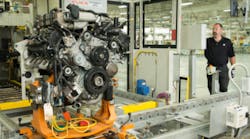Compacted graphite iron cylinder blocks for the new 5.0-liter V8 engines that Cummins Inc. will build and supply to Nissan will be cast by Tupy S.A. at its foundry in Joinville, Santa Catarina, Brazil. Nissan plans to offer the diesel engines as an option for a redesigned version of its Nissan Titan pickup truck.
CGI is a lightweight alternative to gray iron and aluminum for automotive component manufacturing. Diesel engine blocks have been one of the highest-volume applications for CGI, though various other parts have been cast successfully and are in commercial production. In its second-quarter report, SinterCast AB reported that pre-production trials had begun for the first gas-powered CGI engine block.
Tupy is a licensee of SinterCast AB, which developed the most widely used process for commercial CGI production. It’s now under license to numerous automotive foundries worldwide and used to cast nearly 50 different components in series production. A scaled version of the technology is used by several research centers around the world, too.
Cummins offered that its 5.0-liter V8 turbo diesel has been optimized for redesigned Titan pickup, adding that it’s also developing a version of the engine for commercial vehicle customers.
The date of availability for the diesel option is not certain, nor is there any official information on the terms of Cummins’ order. The engine builder is said to be updating its Columbus, IN, plant to produce the diesels for Nissan, and expects to hire as many as 500 new workers when the engine program is at full production.
According to Cummins, the new engine is still in development but Nissan has said it would deliver more than 300 horsepower and about 550 lb./ft. of torque. However, Nissan is said to be conducting highway testing of the new Cummins engine already.
Nissan hopes that redesigning the Titan, and introducing options for engines and body styles, will improve its sales in the truck market.
Adding diesel engine options for midsized trucks is an effort to deliver fuel economy as a feature to the already popular class of vehicles. In addition to Nissan, Chrysler Corp. is offering a 3.0-liter V6 turbo diesel for its 2014 Jeep Grand Cherokee and Dodge Ram 1500 pickups (another SinterCast order, via VM Motori S.p.A.), and General Motors is expected to offer 2.5- or 2.8-liter four-cylinder turbo diesel engines to its new Chevrolet Colorado and GMC Canyon models.
"Better fuel economy, higher torque, increased driving range and lower total cost of ownership make diesels ideally suited to light duty pick-up trucks and the North American driving mode,” explained SinterCast president and CEO Dr. Steve Dawson.
"With approximately 50% of the U.S. market share being held by pick-ups, SUVs and crossovers, the increased use of diesel engines provides an important contribution toward helping OEMs meet the continual increase in Corporate Average Fuel Economy (CAFÉ), as the standard increases from 27.5 miles per gallon (8.6 liters/100km) in 2010 to 54.5 mpg (4.3 liters/100 km) in 2025."









